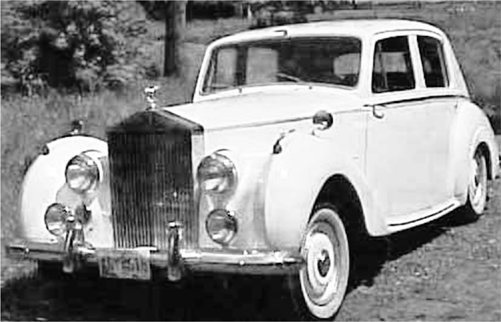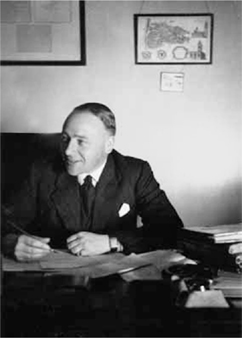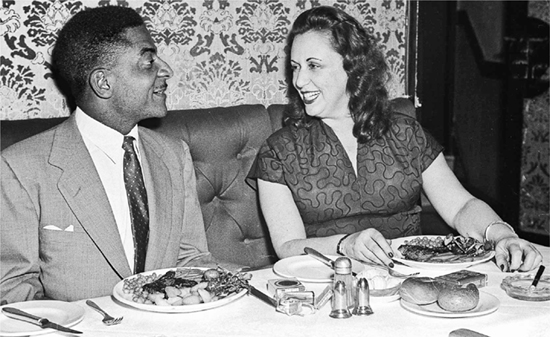
Nica left home in style. She did not take a discreet apartment in London, or a cottage on one of the family’s estates. Instead she moved into a suite at the Stanhope Hotel, a grand establishment overlooking the Metropolitan Museum of Art on the edge of New York’s Central Park. Built in 1927, it was, like many Rothschild houses, a faux version of a European chateau. Guests passed through a neo-Italianate entrance into an opulent eighteenth-century French-style lobby with antiques, marble floors and hand-carved wall mouldings burnished with 24-carat gold leaf. Male guests were expected to wear suits and ties, and women rarely left the premises without hats and gloves. Like many hotels, the Stanhope rigorously maintained a policy of segregation: blacks were allowed in only through the service entrance, and would certainly not have been permitted to rent a room or to frequent public areas or guests’ bedrooms.
The hotel wasn’t a stranger to controversy. In 1946, the American socialite Kiki Preston jumped to her death out of a high window. The alleged mother of one of HRH Prince George’s illegitimate children, a member of the Happy Valley set and a niece of Gloria Vanderbilt, she had been given the nickname “the girl with the silver syringe” on account of her penchant for narcotics. Ms. Preston’s unfortunate leap raised many questions about life behind the heavy, ruched curtains at the Stanhope Hotel. The last thing the management needed was another scandal, yet the ink was hardly dry on Nica’s registration form when she began to cause trouble.

Nica’s first home in New York, a suite at the Stanhope Hotel, overlooking Central Park (Photographic Credit 15.1)
“One of the stories that I used to hear about her,” my father Jacob told me, “was that she liked to practise her pistol shooting on the light bulbs. She had to keep her ‘eye in’ following the war. From time to time my grandfather [Nica’s brother Victor] had to go over to New York to persuade the management to allow her to stay.” Nica confirmed the story to me but added, “The manager said, ‘We don’t mind if you shoot our staff but please leave our chandeliers alone.’ ”
Nica’s first major purchase was a new Rolls-Royce that she would park in front of the Stanhope, leaving the engine running in case she needed to depart in a hurry. Later she would switch her allegiance to Bentleys, although all her cars were treated with gay abandon. “She always drove as if she were competing at Le Mans, and she paid very little attention to traffic rules,” her son Patrick told a journalist. “In my parents’ divorce settlement there’s a clause my father insisted upon: under no conditions were any of us children to ride in a car driven by Nica. A condition that was largely ignored.”

Nica’s first New York car, a 1953 Rolls-Royce Silver Dawn (Photographic Credit 15.2)
One late night in Manhattan, at a red light, a shiny sports car pulled up next to her Bentley Continental Convertible. The elegant gentleman driving the sports car signalled her to roll down her window.
“Madam, you should be ashamed of yourself. You have a rare and beautiful car, but you treat it in a disgraceful manner.”
She looked at the gentleman concerned and replied, “Fuck you!” Then she sped off.
He caught up with her at the next red light and, once again, asked her to roll down her window. Despite their previous encounter, she did so. The gentleman said, “Madam, with all due respect, the same to you!”
He was, she declared, “a lovely man.”
Although these stories made me laugh, they also made me uncomfortable. Nica’s newly chosen lifestyle of grand hotels and fast cars seemed like pure hedonism rather than a spiritual “calling.” I saw an analogy between the way Nica drove the Bentley and the manner in which she discarded her former life; both were, in many respects, rare and beautiful, and she treated both with a careless disdain. I wondered, too, whether there were parallels between Victor disposing so readily of his inheritance to pursue his own passions and Nica walking away from her responsibilities.
Jules’s behaviour might have been controlling and authoritarian, but I felt nothing but sympathy with his desire to protect his children. Wanting to believe that Nica had put up a great fight to keep custody of all her children, I tried to find out details of the couple’s divorce settlement. I combed contemporary newspapers, looking for any mention of custody battles, and searched family letters for references. I found nothing. My respect for Nica wavered. Perhaps she was nothing more than a wealthy, irresponsible gadfly after all.
A civil war of opinion raged in my head. Was she good or bad? Naive or callous? I wasted hours in pointless speculation and then called a mental truce. It was time to stop judging Nica and attempt instead to understand her actions through the prism of her own experiences and the conventions of that time. What of her own childhood? She had never been parented; her father had died abruptly and violently. Rozsika was a ghostly figure who left the business of mothering to the servants. In turn, the children learned to avoid intimacy. Victor used cruelty to keep others at arm’s length and he tormented and bullied many of his five children as well as his two wives. Liberty could not cope with relationships of any kind. Miriam worked obsessively. Nica dodged getting close to anyone by scattering her love widely. Her photograph albums show a woman permanently surrounded—either by cats, children or adults.
Nica’s marriage and her subsequent peripatetic lifestyle meant that she could, when she chose, easily lose contact with people. One Rothschild cousin described her feelings about Nica with both sadness and mystification. The two women were contemporaries and lived in neighbouring houses. As children, they played, hunted hounds and husbands together. Their close friendship endured even when Nica and Jules went to live in France. However, once Nica left Jules she never contacted her cousin nor returned her calls or letters, as if “she simply didn’t want to know me any more.”
One of Nica’s favourite expressions came from the hunting field. “If you throw your heart over the fence, your head will follow,” she told me. Perhaps she should have added, “And do not look back.” She moved to America confident that everything would work out; others would provide and her children would be well cared for by Jules. Her eldest son Patrick said of her financial affairs, “My mother was comfortable, she had a trust fund, but she always had money worries.” Nica spent money she did not have, assuming correctly that her family would bail her out of difficulties. Our cousin Evelyn de Rothschild remembers that a senior bank manager, Mr. Hobbs, was regularly sent to New York to keep tabs on Nica’s spending and encourage a more cautious existence. I imagined Mr. Hobbs as a suburban chap with a bowler hat, being unprepared for travel to America in pursuit of a wayward Rothschild. “No! You’ve got it all wrong,” another cousin corrected me. “Hobbs was a ladies’ man. He looked after all the Rothschild women and he loved it.”

R. W. C. Hobbs, Esq. (Photographic Credit 15.3)
There was another practical explanation for the terms of Nica’s separation. Prior to an Act of Parliament passed in 1969, many years after Nica’s marriage ended, wives were rarely granted alimony or gained custody of their children. Although it was an unusual case, when Frances Shand Kydd, the mother of Diana, the Princess of Wales, left her husband for another man in 1967, she lost custody of her children and received no financial support. Until Princess Margaret got divorced in 1969, only two groups of people were banned from the royal enclosure at racecourses: convicted felons and divorcees. Perhaps Nica did not fight harder for custody of her younger children because she knew she could not win. Perhaps she was honest enough to admit that her younger children would have a more stable life with their father.
Nica’s eldest daughter Janka joined her mother in New York. In her letters, Nica treats her like a younger sister rather than a child, taking pride in Janka’s knowledge of jazz and their shared love of music and musicians. Later Patrick tried living with Nica but complained that the all-night jam sessions made studying impossible. The three younger children, Berit, Shaun and Kari, lived with their father in New York from 1953 until 1957 while Jules held the position of French Minister Plenipotentiary to the United States and Canada. Later they moved with him to Peru where Jules was made Ambassador.
For those in search of a new life, post-war New York was the crucible of creative innovation and a locus of tremendous energy. The economy was booming. It was also a place where being a foreigner was normal. A cacophony of different languages could be heard on any block. Within a few miles of each other, Chinese neighbourhoods bordered Italians, Koreans, Africans, West Indians, Russians, Poles, Jews, Muslims and Hispanics. Most of them lived happily cheek by jowl. What better destination, then, for Nica, a woman of Hungarian-British-German-Jewish extraction, married to a Frenchman of Austrian lineage, who had lived in Europe, Africa and North America?
As the cost of living was relatively cheap, New York became a magnet for leading protagonists in the worlds of art, literature, dance, poetry, music, philosophy and psychoanalysis. Ideas, images and thoughts were incubated in cafés, bars and jazz clubs. Nica’s friend Phoebe Jacobs sums up the city’s attraction: “She came here because we had a freedom that didn’t exist elsewhere. We said to hell with manners or good taste. It was so exciting and she wanted to be one of the crowd, one of the boys.”
Like Nica, Sal Paradise, the hero of Jack Kerouac’s novel On the Road, ends up in New York in the 1950s.
Suddenly I found myself on Times Square; and right in the middle of a rush hour, too, seeing with my innocent road-eyes the absolute madness and fantastic furore of New York with its millions and millions hustling forever for a buck among themselves, the mad dream—grabbing, taking, giving, sighing, dying, just so they could be buried in those awful cemetery cities beyond Long Island City. The high towers of the land—the other end of the land, the place where Paper America is born.
The jazz clubs on 52nd Street were tiny and the same clientele went night after night. Nica sat with Kerouac, William Burroughs, Allen Ginsberg and Abstract Expressionist painters like Jackson Pollock, Willem de Kooning, Franz Kline and Frank Stella, listening to Charlie Parker, Dizzy Gillespie, John Coltrane and Miles Davis. They were joined by an emerging generation of American novelists including Saul Bellow and Norman Mailer who were also transfixed by the jazz scene. The music bled into other art forms, inspiring the Black Mountain poets to reject control and structure. Painters like Robert Rauschenberg used the cut-up technique on canvas, while William Burroughs clipped phrases from newspapers to create a collage of words and meaning.
John Dankworth, Nica’s British saxophone-playing friend, was in New York at that time, listening to the same music. “It was a fantasy world especially if you had just come from war-torn Europe where everything was still rationed and we were suffering the worst weather we had had for half a century. New York was the nearest thing to heaven I could ever remember. I can well understand Nica wanting to be part of it.”
Since the Cotton Club had opened its doors in the 1920s, many white people frequented jazz clubs. What set Nica apart, though, was that she didn’t want to go home when the joints closed. Clint Eastwood, the film director, who got to know Nica when he was making the film Bird about Charlie Parker, told me, “Society people would slum it and go down to hear swing or jazz bands. Nica embraced the whole culture of jazz and bebop and loved the rebelliousness of it.”
Robin Kelley, Monk’s biographer, added another dimension to Nica’s behaviour. “From everything I have heard, she lived a very protected life as a child. She almost died when she caught measles as an adult. I think that kind of seclusion, that kind of protection, is enough to make you go wild when you become an adult.”
For the next thirty years Nica’s lifestyle barely changed. She did not just listen to jazz; she lived it. She got up as darkness fell. She wasted daylight, treating it with utter contempt.
Within months of settling in America, Nica replaced the internecine web of cousins with an equally complicated maze of musicians. The aristocracy that she knew so well in England was now replaced by a “jazzocracy.” She learned who had influenced, betrayed, loved, nurtured and copied whom. Adopting the patois, the hours and habits, Nica became a jazz native.
When Nica arrived on the scene with her gleaming white Rolls-Royce, her chequebook and her unbounded enthusiasm for their music, the musicians could not believe their luck. She took them seriously and was happy to pay for a night out, offering both cash and cachet. “I remember one night we had dinner at her place,” Horace Silver wrote in his autobiography. “We decided to go to Birdland.* We got in her Rolls-Royce, with her driving, and proceeded down Broadway. I remember all the white people staring at us as if to say, ‘What are those niggers doing in a Rolls-Royce with a white lady?’ ”
Nica was not worried about spending what money she had. What she wanted was an entrée to a different life and the musicians gave it to her. Her grandson Steven told me: “To her that music was the ultimate expression of freedom and that was something that she had never experienced until she went to New York.”
Nica’s words, as told to Nat Hentoff for the piece in Esquire, confirm her grandson’s hunch. “The music is what moves me. It has something I also hear in the playing of the Hungarian gypsies, something very sad and beautiful. It’s everything that really matters, everything worth digging. It’s a desire for freedom. And in all my life, I’ve never known any people who warmed me as much by their friendship as the Jazz musicians I’ve come to know.”
Many assumed that Nica’s relationship with the musicians was physical. “Black man, white woman, it had to be all about sex didn’t it? That’s the normal, offensive, old prejudice coming out,” her friend, the trombonist Curtis Fuller, said sadly. Curtis spent a lot of time with Nica from the late 1940s. “I never saw any touchy-feely stuff. Besides, if you had had five kids, wouldn’t you just want a bit of a rest from all that?”

Nica with Teddy Wilson at London’s Stork Club in 1954 (Photographic Credit 15.4)
The drummer and ladies’ man Art Blakey was the first musician with whom Nica was romantically linked. She bought him a Cadillac and fitted out his band with suits. Many thought Blakey used Nica but to her he was an amusing, talented guide to the jazz world, introducing her to musicians and clubs, and teaching her about music. Another musician with whom she was supposed to have had an affair was Al Timothy, a Trinidadian saxophonist who had arrived in Britain in 1948 and met Nica through their mutual friend Teddy Wilson. Apparently, Nica loved Timothy or his music or both, and when she returned briefly to live in London in 1954, she reopened the club Studio 51 and made him resident bandleader. Later Timothy came to visit Nica in New York, where she photographed him with Monk and Sonny Rollins.
Gossip and speculation stalked Nica but there is no evidence that any of these relationships were consummated. One of her closest friends was her brother’s old piano teacher Teddy Wilson. When he went on tour in Scotland in 1953, Nica drove him from London to Edinburgh. Again the newspapers had a field day. “Blues Man Gets Rolls Royce” was one headline. For Wilson, seeing the United Kingdom “in a four-door sedan, with the sun roof open, at highway speeds” was seeing the country at its best. For Nica, with time on her hands and a car at her disposal, it was “a blast.”
The irony was that she still could not find the man who wrote “ ’Round Midnight.” Nica combed the clubs, looking for the High Priest of Jazz, but Thelonious Monk had been in prison, and now he was broke, living as a virtual prisoner in his own apartment.
*Birdland, the landmark jazz club on Broadway, was established in 1949, named after Charlie Parker, whose nickname was “Bird.”